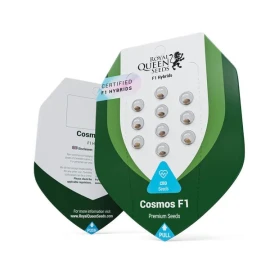Apollo F1
11,25 €
Apollo F1 Overview
Apollo F1 represents the cutting-edge of autoflowering cannabis genetics, combining the uniformity and vigor of true F1 hybrid technology with an exceptional 75-80 day seed-to-harvest cycle. This indica-dominant strain delivers consistent 20-25% THC potency across every plant, making it ideal for both novice growers seeking reliability and experienced cultivators maximizing small-space yields. With its compact stature and impressive indoor yields up to 600g/m², Apollo F1 offers the perfect solution for discrete indoor operations and time-conscious growers.
This comprehensive guide covers everything from the strain’s complex genetic lineage through detailed growing techniques, troubleshooting common issues, and optimizing your harvest for maximum potency and flavor expression.
Quick Facts
| Genetics: | Lemon × Black Domina × Sugar Magnolia (80% Indica / 20% Sativa) |
| Type: | Autoflowering F1 Hybrid (Feminized) |
| THC Content: | 20-25% |
| CBD Content: | <1% |
| Life Cycle: | 75-80 days (seed to harvest) |
| Height: | 60-80 cm indoors (compact, bushy structure) |
| Indoor Yield: | 500-600 g/m² |
| Outdoor Yield: | 150g+ per plant |
| Dominant Terpenes: | Myrcene, Terpinolene, Farnesene, Caryophyllene, Ocimene, Limonene, Linalool |
| Aroma Profile: | Bright citrus and lemon with pine undertones, vanilla sweetness, lavender florals, and earthy finish |
| Ideal For: | Small to medium indoor grows, beginner-friendly setups, fast turnaround cycles, uniform commercial production |
Understanding F1 Hybrid Genetics
Apollo F1 showcases true F1 hybrid vigor, representing the first-generation cross between carefully selected parent lines. F1 hybrids deliver exceptional uniformity, meaning every seed produces plants with nearly identical characteristics – a crucial advantage for commercial growers and those seeking predictable results.
The genetic foundation combines three distinct lineages:
Lemon contributes the signature citrus terpene profile, particularly high limonene content that provides the strain’s bright, energizing aroma and mood-lifting properties.
Black Domina brings the indica structure and resin production, contributing to the compact growth habit, dense bud formation, and elevated THC levels that define Apollo F1’s potency.
Sugar Magnolia adds the complex floral and vanilla aromatics, introducing terpinolene and linalool that create the strain’s sophisticated scent profile and contribute to its balanced effects.
This three-way hybridization achieves the breeder’s primary objectives: combining indica resin production and manageable plant size with complex terpene expression and shortened autoflowering cycles. The result is a strain that maintains the reliability of traditional indica genetics while expressing the aromatic complexity typically found in longer-flowering sativa varieties.
Aroma, Flavor & Terpene Profile
Apollo F1 presents a sophisticated sensory experience dominated by bright citrus notes with substantial depth and complexity. Upon opening a properly cured jar, expect an immediate burst of fresh lemon and pine, followed by subtle vanilla sweetness and lavender undertones that reveal the strain’s genetic complexity.
The comprehensive terpene profile creates multiple layers of aroma and effects:
Myrcene forms the aromatic foundation with earthy, musky notes that promote physical relaxation and enhance the absorption of other cannabinoids, contributing to the strain’s body-centric effects.
Terpinolene provides fresh, floral brightness with subtle pine characteristics, contributing to the uplifting mental effects and preventing the indica genetics from becoming overly sedating.
Farnesene adds green, woody freshness that complements the citrus notes while contributing to the strain’s calming properties without heavy sedation.
Caryophyllene introduces spicy, peppery undertones and may interact with CB2 receptors, potentially providing anti-inflammatory benefits and adding complexity to the flavor profile.
Ocimene contributes sweet, herbal brightness that enhances the overall aromatic appeal and adds to the strain’s energizing qualities.
Limonene dominates the citrus expression, providing mood-lifting properties and the characteristic lemon aroma that makes Apollo F1 immediately recognizable.
Linalool rounds out the profile with lavender florals that promote relaxation and stress relief, balancing the more energizing terpenes.
When consumed, expect initial citrus brightness on the inhale, followed by complex herbal and pine notes, finishing with subtle vanilla and floral undertones that linger pleasantly. The terpene combination creates a remarkably clean taste profile that showcases proper curing and genetic quality.
Effects, Potency & Usage Scenarios
Apollo F1 delivers a balanced experience that leans toward indica relaxation while maintaining mental clarity and creative energy. The 20-25% THC content provides substantial potency that requires measured dosing, particularly for occasional users.
The effect profile typically unfolds as follows:
Physical Effects include gentle muscle relaxation without heavy couch-lock, making Apollo F1 suitable for evening activities that don’t require high mobility. Users report tension relief in shoulders and neck, mild body warmth, and overall physical comfort that encourages relaxation without complete sedation.
Mental Effects begin with mood elevation and subtle euphoria, often accompanied by enhanced creativity and focus during the initial phases. The sativa genetics prevent the heavy mental fog associated with pure indica varieties, allowing for engaging conversations, artistic pursuits, or light entertainment.
Onset and Duration vary by consumption method. Inhalation typically produces effects within 2-5 minutes, reaching peak intensity around 30-60 minutes, with total duration of 2-4 hours. Oral consumption extends both onset (30-90 minutes) and duration (4-8 hours) significantly.
Recreational Applications include evening social gatherings, creative projects, movie watching, music appreciation, and moderate physical activities like gentle yoga or stretching. The balanced nature makes it suitable for situations requiring some mental engagement without intense physical demands.
Therapeutic Considerations may include stress relief, mild insomnia support, muscle tension reduction, and mood enhancement. The terpene profile suggests potential benefits for anxiety management and general relaxation, though individual responses vary significantly.
Dosage Guidance recommends starting with small amounts, particularly given the potent THC levels. New users should begin with single inhalations and wait at least 15 minutes before additional consumption. Experienced users can adjust based on tolerance, but the strain’s potency demands respect.
Common Side Effects include dry mouth, dry eyes, and potential dizziness with overconsumption. Higher doses may produce anxiety or paranoia in sensitive individuals. Proper hydration and controlled environment help minimize adverse effects.
Complete Growing Guide: Seed to Harvest
Apollo F1’s autoflowering nature simplifies cultivation while the F1 genetics ensure consistent results across all plants. The 75-80 day lifecycle allows multiple harvests per year in suitable climates.
Week-by-Week Timeline
Week 0-1: Germination Phase
Seeds typically sprout within 24-72 hours using standard germination methods. Maintain humidity around 70% and temperatures between 22-25°C. Once taproots appear, transfer to starter medium with minimal nutrients. Provide gentle lighting (18-20 hours daily) at reduced intensity.
Week 1-3: Early Vegetative Growth
Rapid root development accompanies explosive above-ground growth. True leaves develop quickly, and nodes begin forming the foundation for future bud sites. Maintain consistent watering without oversaturation. Begin low-intensity nutrient feeding at quarter strength.
Week 3-5: Mid-Vegetation to Pre-Flower
First pistils typically appear around week 3-4, signaling the transition to flowering regardless of light schedule. This is the ideal time for low-stress training to shape the canopy. Increase nutrient strength gradually, focusing on balanced NPK ratios.
Week 5-10: Full Flowering Development
Dense bud formation accelerates rapidly. Monitor humidity carefully to prevent mold issues. Reduce nitrogen while increasing phosphorus and potassium. Support branches as buds gain weight. Maintain optimal environmental conditions for resin production.
Week 9-11: Ripening and Harvest Window
Trichomes transition from clear to cloudy to amber. Harvest timing depends on desired effects – mostly cloudy trichomes provide balanced effects, while increased amber content enhances sedative properties. Typical harvest occurs around day 75-80.
Environmental Requirements
Lighting: Apollo F1 thrives under 18/6 or 20/4 light schedules throughout its lifecycle. Provide 300-600 µmol/m²/s PPFD during vegetative and flowering phases. LED fixtures offer excellent results with lower heat production.
Temperature: Maintain 20-26°C (68-79°F) during lights-on periods. Avoid exceeding 28°C, which can stress plants and reduce resin production. Night temperatures can drop 5-10°C for optimal development.
Humidity: Start with 65-70% during seedling phase, reduce to 45-60% during vegetation, and lower to 35-45% during late flowering to prevent bud rot.
pH Management: Soil grows require 6.0-6.5 pH, while hydroponic and coco systems perform best at 5.5-6.0 pH. Regular monitoring prevents nutrient lockout.
Growing Medium and Nutrition
Soil Selection: Use light, well-draining soil mixes with good aeration. Avoid heavy nutrient loads initially, as autoflowers are sensitive to overfeeding during early stages.
Feeding Schedule: Begin with quarter-strength nutrients after true leaves develop. Gradually increase to half-strength during mid-vegetation. Reduce nitrogen during flowering while boosting phosphorus and potassium. Flush with plain water 7-14 days before harvest.
Container Size: 7-11 liter pots provide optimal root space for indoor cultivation. Larger containers support bigger plants but require more space and resources.
Training Techniques
Low-Stress Training (LST) works exceptionally well with Apollo F1’s bushy structure. Gently bend and tie main stems to expose lower bud sites to light. Begin LST around week 2-3 for best results.
Screen of Green (SCROG) can maximize yields in limited vertical space. Install screens 20-30cm above pots and weave growing tips through openings as plants develop.
Avoid High-Stress Techniques such as topping, fimming, or heavy defoliation. Autoflowers have limited recovery time, and stress can significantly reduce yields or delay harvest.
Harvest Indicators
Trichome Assessment provides the most accurate harvest timing. Use a jeweler’s loupe or digital microscope to examine trichomes on buds (not leaves). Clear trichomes indicate early harvest, cloudy trichomes suggest peak THC, and amber trichomes indicate CBN conversion and more sedative effects.
Visual Cues include pistil color changes (white to orange/brown), bud swelling, and overall plant appearance. Healthy plants show yellowing fan leaves as they redirect energy to bud development.
Drying and Curing significantly impacts final quality. Hang trimmed branches in dark conditions at 45-55% humidity and 18-21°C for 7-10 days until small stems snap cleanly. Cure in glass jars, burping daily for two weeks, then weekly. Proper curing develops terpene complexity and smooths the smoking experience.
Troubleshooting Common Issues
Yellowing Lower Leaves Early in Growth
Often indicates nitrogen deficiency or overwatering. Check soil moisture levels and drainage. If soil drains properly, increase nutrient strength gradually. Distinguish from natural late-flowering yellowing, which is normal and expected.
Leaf Tip Burning and Curling
Classic signs of nutrient burn from excessive feeding. Flush growing medium with plain, pH-adjusted water and reduce nutrient concentration to half strength. Resume feeding gradually as plants recover.
Stunted Growth or Slow Development
Common causes include root binding in small containers, poor drainage, temperature stress, or pH imbalances. Transplant to larger containers if roots circle the pot bottom. Improve drainage and check environmental conditions.
Bud Rot and Powdery Mildew
Prevention is crucial – maintain air circulation, control humidity, and avoid overcrowding. Remove infected material immediately and isolate affected plants. Increase air movement and reduce humidity if possible.
Pest Management
Spider mites, aphids, and other common pests can be managed with integrated pest management approaches. Increase humidity temporarily to discourage mites, introduce beneficial insects, or use appropriate organic treatments. Isolate affected plants to prevent spread.
Stretching and Excessive Height
Usually results from insufficient light intensity or excessive distance between lights and canopy. Increase light intensity or move fixtures closer. Use LST to control height and encourage bushier growth.
Performance Expectations
Apollo F1 consistently delivers impressive results across various growing conditions. Indoor cultivators can expect 500-600 g/m² under optimal conditions with proper lighting, nutrition, and environmental control. Individual plant yields often reach 50-100g in 7-11 liter containers.
Outdoor cultivation in suitable climates produces 150g+ per plant, with some exceptional specimens exceeding 200g when provided adequate space and optimal conditions. The compact size makes Apollo F1 excellent for discrete outdoor cultivation.
Plant height remains manageable at 60-80cm indoors, though outdoor plants may reach slightly taller depending on container size and growing season length. The bushy structure and multiple bud sites create dense, resinous flowers that cure to exceptional quality.
The F1 genetics ensure remarkable uniformity across all plants, eliminating the phenotype variation common with regular seeds. Every plant exhibits similar height, structure, flowering time, and potency, making Apollo F1 ideal for commercial operations requiring consistency.
Disease resistance is notably strong, with plants showing tolerance to common issues like powdery mildew, bud rot, and pest pressure when grown under appropriate conditions. The robust genetics allow successful cultivation even with minor environmental fluctuations.
Strain Comparison Analysis
Apollo F1 distinguishes itself from other autoflowering varieties through its true F1 genetics, exceptional uniformity, and balanced effect profile. Compared to typical autoflowering indica hybrids, Apollo F1 offers significantly higher yields, shorter cycles, and more complex terpene expressions.
The 20-25% THC content places Apollo F1 in the high-potency category, exceeding many autoflowering varieties that typically range from 15-20% THC. The comprehensive terpene profile creates more sophisticated aromas and effects than single-dominant-terpene strains.
Cycle time of 75-80 days competes favorably with other fast autoflowers while maintaining high yield potential. Many rapid autoflowers sacrifice yield for speed, but Apollo F1 maintains both characteristics through advanced breeding.
The compact 60-80cm height suits small-space cultivation better than stretchy sativa-dominant autoflowers, while the indica-leaning effects provide relaxation without the heavy sedation of pure indica genetics.
For growers prioritizing yield, Apollo F1’s 500-600 g/m² potential exceeds most autoflowering varieties. For those seeking complex flavors, the multi-layered terpene profile surpasses simpler, single-note strains. Time-conscious cultivators benefit from the rapid 75-80 day cycle without compromising quality.
Beginner Growing Tips
Apollo F1 ranks among the most beginner-friendly autoflowering strains due to its forgiving nature, uniform genetics, and minimal training requirements. New growers can achieve excellent results by following basic cultivation principles without advanced techniques.
Seed Selection and Storage
Purchase seeds from reputable sources to ensure genetic authenticity and germination rates. Store unused seeds in cool, dry, dark conditions. Refrigeration (not freezing) with desiccant packs maintains viability for extended periods.
Essential Equipment Checklist
- 80x80cm or larger grow tent for 2-4 plants
- Full-spectrum LED light (300-600W actual draw)
- 7-11 liter fabric pots with drainage
- Quality soil mix designed for cannabis
- pH testing kit and adjustment solutions
- Digital thermometer/hygrometer combo
- Oscillating fan for air circulation
- Basic nutrient kit designed for autoflowers
Simplified Growing Approach
Focus on environmental stability rather than complex techniques. Maintain consistent lighting, moderate feeding, and appropriate watering schedules. Avoid overcomplicating the process with unnecessary additives or frequent adjustments.
Common Beginner Mistakes to Avoid
Overwatering ranks as the most common error – allow soil to dry slightly between waterings. Overfeeding can burn plants quickly – start with half-strength nutrients and increase gradually. Excessive handling or training can stress autoflowers unnecessarily.
Success Indicators
Healthy Apollo F1 plants show rapid early growth, develop multiple nodes quickly, and transition to flowering smoothly around week 3-4. Dense bud development and strong aromas indicate proper environmental conditions and nutrition.
Responsible Use and Safety Information
Apollo F1’s 20-25% THC content requires careful dosing and responsible consumption practices. The potency can surprise even experienced users, particularly when consuming edibles or concentrates made from the flower.
Dosage Guidelines
New users should start with single inhalations and wait 15 minutes before additional consumption. The effects can intensify over the first hour, so patience prevents overconsumption. Experienced users should adjust based on tolerance but respect the strain’s potency.
Legal Considerations
Verify local and state laws regarding cannabis cultivation, possession, and use. Laws vary significantly by jurisdiction, and compliance is the user’s responsibility. Apollo F1 is intended for adult use only in areas where cannabis is legal.
Health and Safety Precautions
Avoid operating vehicles or machinery while under the influence. Cannabis can impair coordination, reaction time, and judgment. Consult healthcare providers before use if taking medications or managing health conditions.
Side Effect Management
Dry mouth responds well to hydration and sugar-free gum or mints. Dry, irritated eyes benefit from over-the-counter eye drops. Anxiety or discomfort from overconsumption often improves with rest in a comfortable environment, deep breathing, and reminding oneself that effects are temporary.
Storage and Handling
Store finished flower in airtight glass containers away from light, heat, and moisture. Proper storage maintains potency and prevents mold development. Keep all cannabis products away from children and pets.
Frequently Asked Questions
What makes Apollo F1 special compared to other autoflowers?
Apollo F1 utilizes true F1 hybrid genetics that provide exceptional uniformity, vigor, and predictable results. The combination of high yields (500-600 g/m²), fast cycles (75-80 days), and complex terpene profiles sets it apart from typical autoflowering varieties.
Is Apollo F1 suitable for complete beginners?
Yes, Apollo F1 is highly beginner-friendly due to its uniform genetics, disease resistance, and forgiving nature. The strain requires minimal training and responds well to basic cultivation practices, making it ideal for first-time growers.
How long does Apollo F1 take from seed to harvest?
Apollo F1 completes its full lifecycle in 75-80 days, approximately 10-11 weeks from germination to harvest. This rapid cycle allows multiple harvests per year in suitable climates.
What yields can I realistically expect?
Indoor growers typically achieve 500-600 g/m² under optimal conditions, while individual plants often produce 50-100g in appropriate containers. Outdoor cultivation yields 150g+ per plant depending on conditions and container size.
What are the dominant flavors and aromas?
Apollo F1 features bright citrus and lemon notes with pine undertones, vanilla sweetness, and subtle lavender florals. The complex terpene profile includes myrcene, terpinolene, farnesene, caryophyllene, ocimene, limonene, and linalool.
Can I top or heavily train Apollo F1?
Avoid topping or high-stress training techniques with autoflowers. Apollo F1 responds excellently to low-stress training (LST) and light SCROG applications but has limited recovery time for aggressive techniques.
How do I prevent bud rot during flowering?
Maintain humidity below 45% during late flowering, ensure adequate air circulation, provide proper spacing between plants, and monitor dense bud sites regularly. Prevention is far more effective than treatment.
Is Apollo F1 high in CBD?
No, Apollo F1 is CBD-poor with less than 1% CBD content. This is a THC-dominant strain designed for psychoactive effects rather than CBD therapeutic applications.
Apollo F1 represents the pinnacle of modern autoflowering cannabis breeding, combining the reliability of F1 genetics with exceptional potency, complex aromatics, and impressive yields. Whether you’re a beginner seeking consistent results or an experienced grower maximizing efficiency, Apollo F1 delivers outstanding performance in a compact, manageable package that completes its full cycle in just 75-80 days.
Related Products
Frequently Asked Questions
Everything You Need to Know















